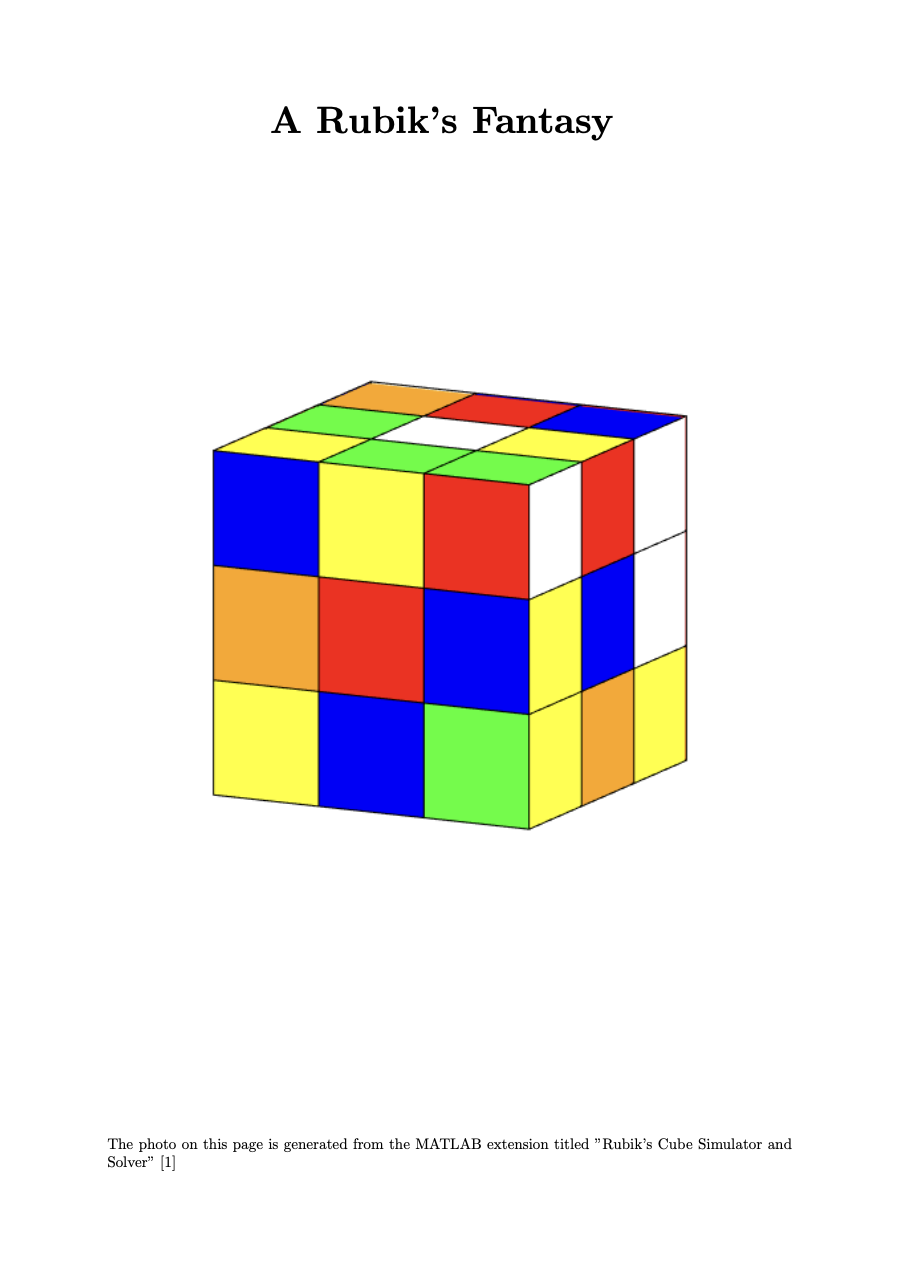A Rubik's Fantasy
DOI:
https://doi.org/10.5195/pur.2025.88Keywords:
Rubik's Cube, Permutations, AlgorithmsAbstract
The Rubik’s Cube is a 3-dimensional puzzle that contains 6 sides known as a face) and nine facets per face. There are 54! possible combinations of rearranging the facets, however, not all rearrangements are types of movements of a Rubik’s cube. The total number of possible movements in the Rubik’s cube is over 43 quintillion [2]. Due to the cube’s nature, many individuals find it challenging to solve. In this paper, we use a 3x3 Rubik’s cube to describe and introduce the concept of permutations. Although permutations are a topic of abstract algebra (or an advanced level of mathematics), they are described in a way accessible to everyone regardless of their mathematical background.
References
J. Heit, “Rubik’s Cube Simulator and Solver.” https://www.mathworks.com/matlabcentral/fileexchange/31672-rubik-s-cube-simulator-and-solver, 2024.
A. Chilakapati, “Understanding the rubik’s cube and why it has over 43 quintillion permutations!.” https://www.cubelelo.com/blogs/cubing/understanding-the-rubiks-cube-permutations, 2023.
D. Joyner, Adventures in Group Theory: Rubik’s Cube, Merlin’s Machine, and Other Mathematical Toys, ch. 3. John Hopkins University Press, 2 ed. ed., 2008.
J. L. Charles Bundrick, Essentials of Abstract Algebra. Brooks/Cole Publishing Company, 1972.
V. J. K. John B. Fraleigh, A First Course In Abstract Algebra, 7th Edition. Boston: Addison-Wesley, 2003.
W. Deskins, Abstract Algebra. New York: The Macmillan Company, 1964.
J. Gallian, Contemporary Abstract Algebra, 8th Edition. Brooks/Cole Cengage Learning, 2013.
J. Heit, “Building and Solving Rubik’s Cube in Mathworks Matlab,” 2011. https: //joren.ralphdesign.nl/projects/rubiks_cube/cube.pdf.
D. M. Bressoud, “§26.13 permutations: Cycle notation.” https://dlmf.nist.gov/ 26.13#E5, May 2010.
R. Academy, “Instructions guide: A simplified process for learning the rubik’s cube.” https://assets-global.website-files.com/64232a313a459248112bb641/64beba803edc0e3159902b0c_Rubik%27s%20Coach%20Cube%20Solve%20Guide.pdf, 2022.
D.-X. Zeng, “Overview of Rubik’s Cube and Reflections on Its Application in Mechanism,” Chinese Journal of Mechanical Engineering, 2018. https://cjme.springeropen.com/counter/pdf/10.1186/s10033-018-0269-7.pdf.
S. Strong, “How to Solve a Rubik’s Cube,” 2016. https://sarah.cubing.net/3x3x3/beginners-method#section/structure.
D. Ferenc, “Rubik’s Cube Algorithms,” 2012. https://ruwix.com/the-rubiks-cube/algorithm/#:~:text=J%20Perms%20These%20are%202%20PLL%20algorithms%20that,%E2%80%93%20can%20also%20be%20very%20fast%20with%20practice.
J. Fridich, “First Two Layers: Examples,” 2003. http://ws2.binghamton.edu/fridrich/examples.html.
G. Zussman, “OLL 44,” 2021. https://speedcubedb.com/a/3x3/OLL/OLL_44.
S. Bouck´e, “Algorithms,” 2015. https://www.speedcubereview.com/algorithms.html.
S. Wiki, “PLL,” Accessed July 28th, 2023. https://www.speedsolving.com/wiki/index.php?title=PLL#A_Permutation_:_a.

Downloads
Published
How to Cite
Issue
Section
License
Copyright (c) 2025 Kaylee Huber

This work is licensed under a Creative Commons Attribution 4.0 International License.
Authors who publish with this journal agree to the following terms:
- The Author retains copyright in the Work, where the term “Work” shall include all digital objects that may result in subsequent electronic publication or distribution.
- Upon acceptance of the Work, the author shall grant to the Publisher the right of first publication of the Work.
- The Author shall grant to the Publisher and its agents the nonexclusive perpetual right and license to publish, archive, and make accessible the Work in whole or in part in all forms of media now or hereafter known under a Creative Commons Attribution 4.0 International License or its equivalent, which, for the avoidance of doubt, allows others to copy, distribute, and transmit the Work under the following conditions:
- Attribution—other users must attribute the Work in the manner specified by the author as indicated on the journal Web site;
- The Author is able to enter into separate, additional contractual arrangements for the nonexclusive distribution of the journal's published version of the Work (e.g., post it to an institutional repository or publish it in a book), as long as there is provided in the document an acknowledgement of its initial publication in this journal.
- Authors are permitted and encouraged to post online a prepublication manuscript (but not the Publisher’s final formatted PDF version of the Work) in institutional repositories or on their Websites prior to and during the submission process, as it can lead to productive exchanges, as well as earlier and greater citation of published work. Any such posting made before acceptance and publication of the Work shall be updated upon publication to include a reference to the Publisher-assigned DOI (Digital Object Identifier) and a link to the online abstract for the final published Work in the Journal.
- Upon Publisher’s request, the Author agrees to furnish promptly to Publisher, at the Author’s own expense, written evidence of the permissions, licenses, and consents for use of third-party material included within the Work, except as determined by Publisher to be covered by the principles of Fair Use.
- The Author represents and warrants that:
- the Work is the Author’s original work;
- the Author has not transferred, and will not transfer, exclusive rights in the Work to any third party;
- the Work is not pending review or under consideration by another publisher;
- the Work has not previously been published;
- the Work contains no misrepresentation or infringement of the Work or property of other authors or third parties; and
- the Work contains no libel, invasion of privacy, or other unlawful matter.
- The Author agrees to indemnify and hold Publisher harmless from Author’s breach of the representations and warranties contained in Paragraph 6 above, as well as any claim or proceeding relating to Publisher’s use and publication of any content contained in the Work, including third-party content.
- The Author agrees to digitally sign the Publisher’s final formatted PDF version of the Work.


